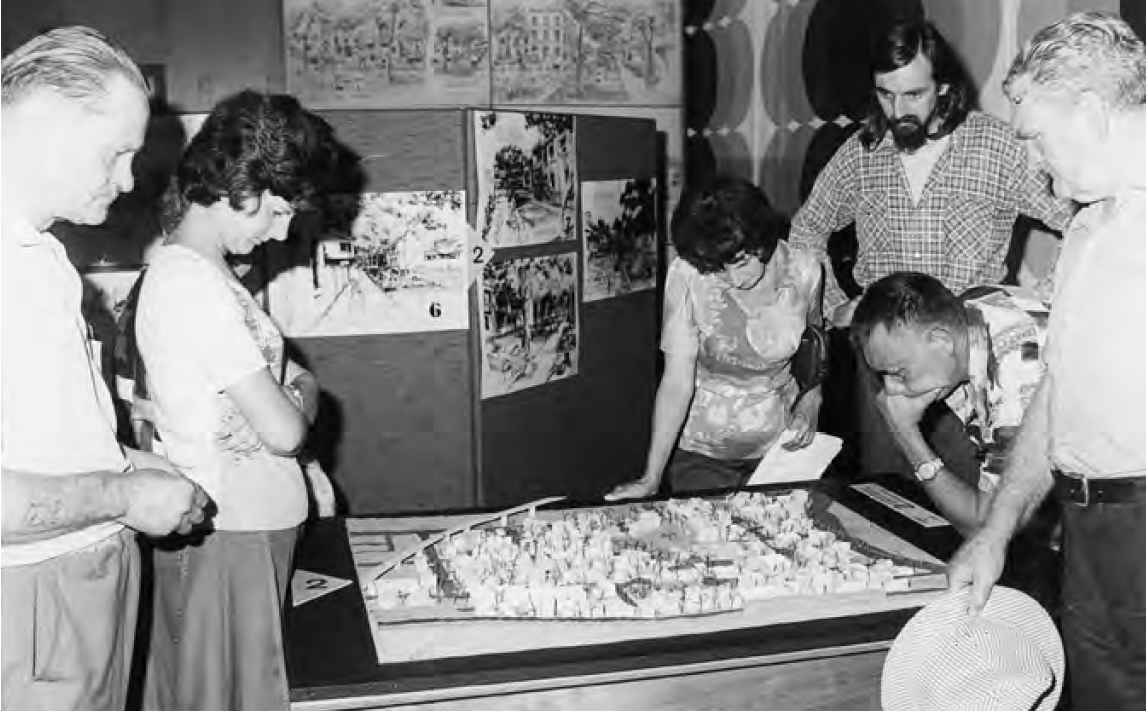Woolloomooloo
Residents Nellie Leonard (back) and Gerry Leonard (with hat) study development plans for Woolloomooloo, circa 1972. (Image source: Green Bans, Red Union)
In 1964 a zoning scheme had earmarked Wolloomooloo for “comprehensive development” with provision for development bonuses for developers who bought and consolidated sites. Developer Sydney Londish took advantage of this, quietly consolidating more than two hundred and seventy properties before announcing plans for a massive high-rise development. The NSW Government also released plans for the Eastern expressway which would cut through the eastern suburb of Sydney as well as resuming another thirty-seven hectares for more commercial development. In addition, the federal government was planning high-rise development on land owned by the Department of Navy.
The redevelopment plans for Woolloomooloo, which were approved in 1971, envisaged around fifty-five per cent of buildings as high-rise office blocks supplements by three skyscraper hotels with 2000 rooms, larger retail, recreation, exhibition and convention centres, and parking for 3400 cars. In face of these threats, the Woolloomooloo Resident Action Group was formed early the following year. In October 1972, a street meeting was held which collected over 1,500 signatures for a petition to keep the area a residential one.
One important resident activist was local priest, historian, and journalist Edmund Campion who instigated the request for a green ban on the entirety of Woolloomooloo. The BLF granted this appeal, announcing on 14 February 1973 that no construction would take place in the area bounded by the Sydney Domain and Victoria, William and Macleay streets. By this time, hundreds of residents had been displaced or evicted both by Londish and the Department of Main Roads, however, the BLF and the bulldozers’ union (FEDFA) refused to demolish any houses.
During the 1972 election, the Labor Party promised to ‘Save the Loo’ and won federal government in December. A committee of representatives from all levels of government was formed and consultations with residents took place. After two years an alternative plan was finally agreed upon which led to a visionary medium density workers’ housing project embracing renewal and new designs. The plan meant that ninety per-cent of the remaining terrace houses were preserved and restored and that the suburb would become an open area of parks and gardens which maintained its residential nature.
Woolloomooloo residents, along with those of Darlinghurst and Kings Cross spent 1973 devising a community plan. Guidelines suggested the area remain low-rise and that rent structures be imposed to ensure people of all classes could live there. It was integral that residential use be retained in favour of any further commercial development and that residents maintained control of the future development of the area. The construction of expressways and the increasing domination of private vehicular traffic was also a concern which needed to be curtailed. By imposing a green ban, the BLF afforded residents the opportunity to fight and the time to prepare this community plan.
Verity and Meredith Burgmann, Green bans, red union: the saving of a city, 1998; Lee Rhiannon and NSW Greens Party, Green Bans: Inspirational Activism, 2016; Anne Summers (et al.), The little green book: the facts on green bans, 1973.
Research provided by Isabella Maher



